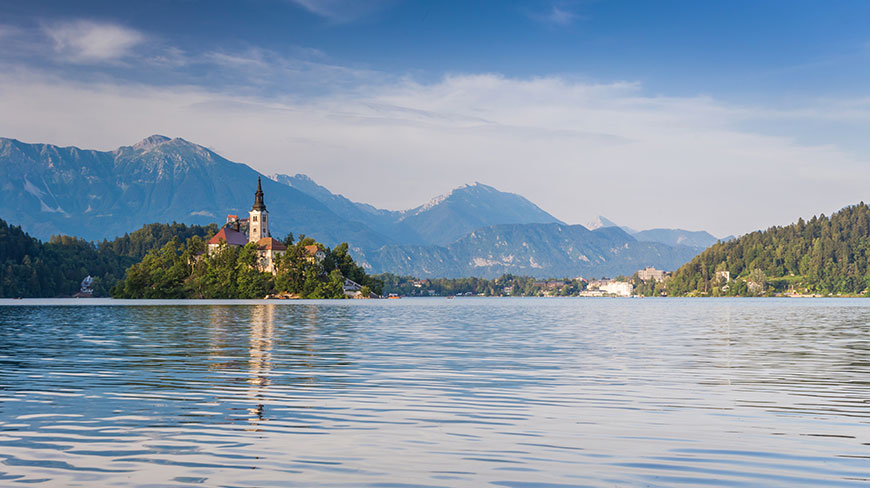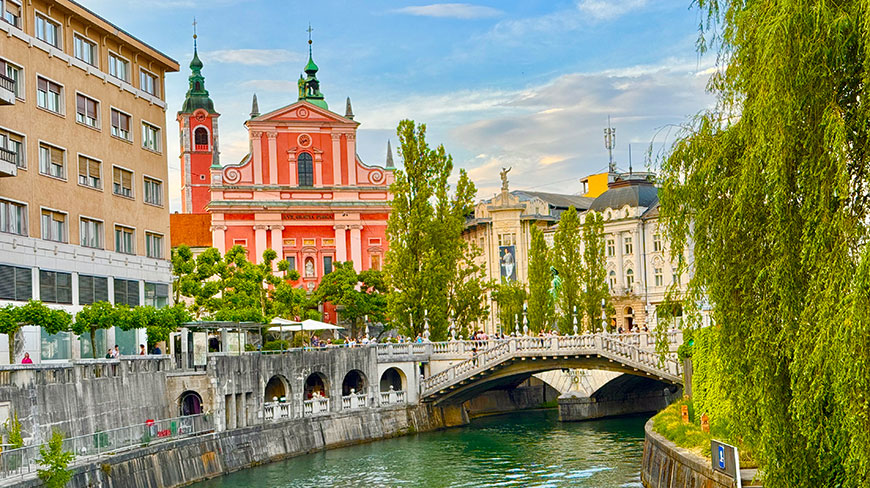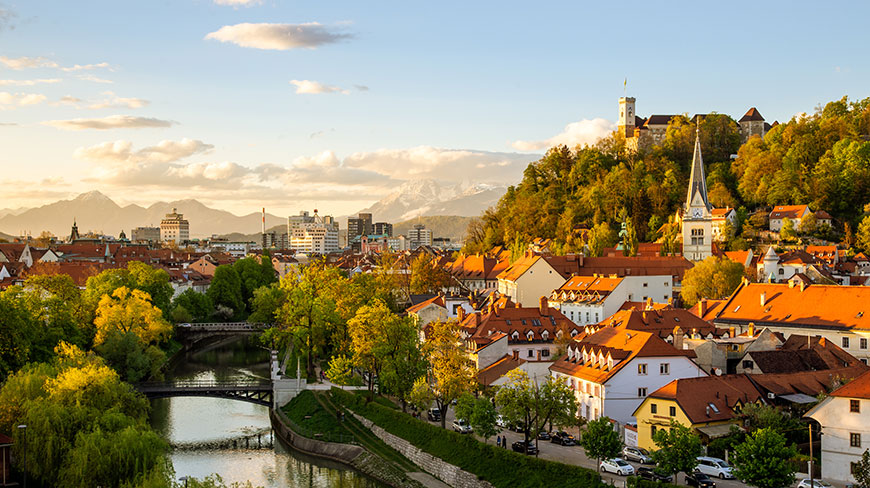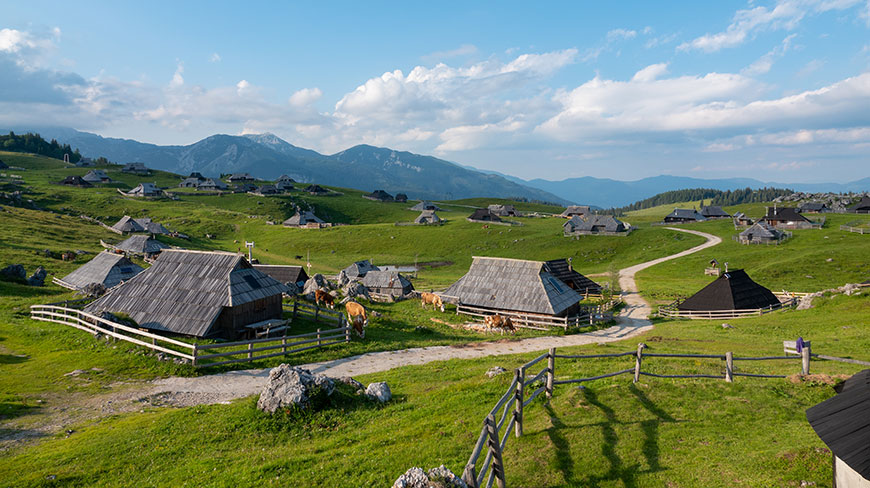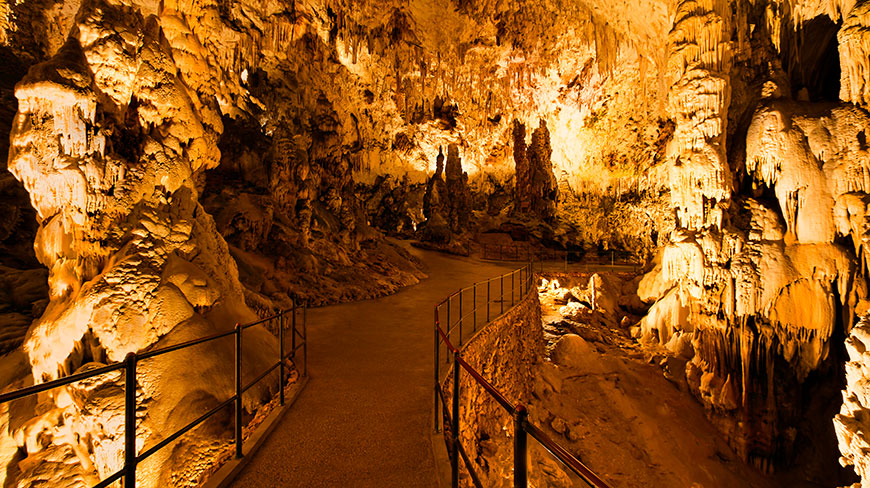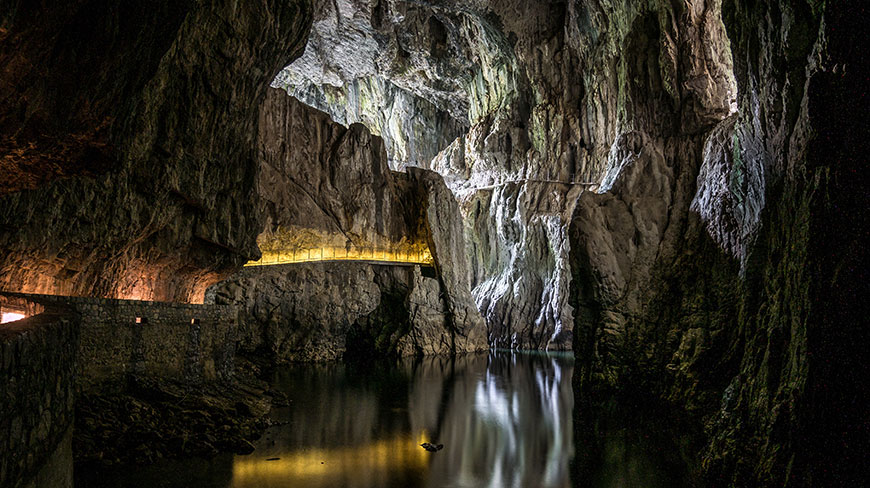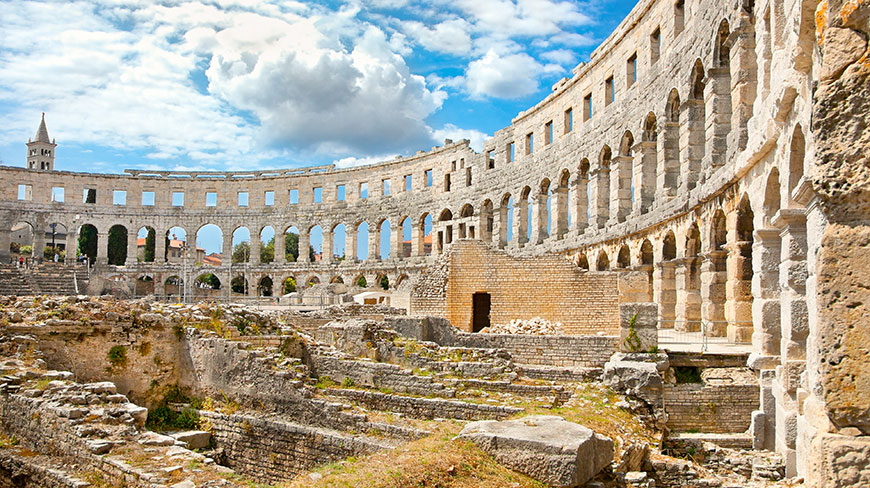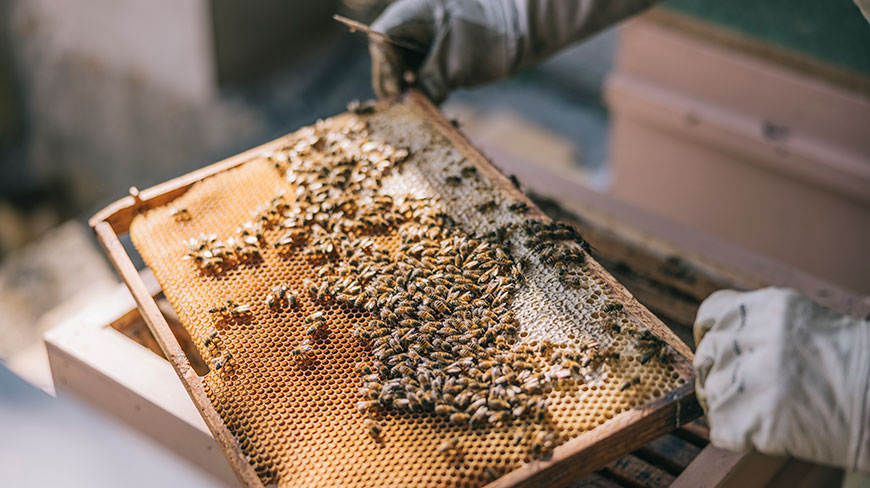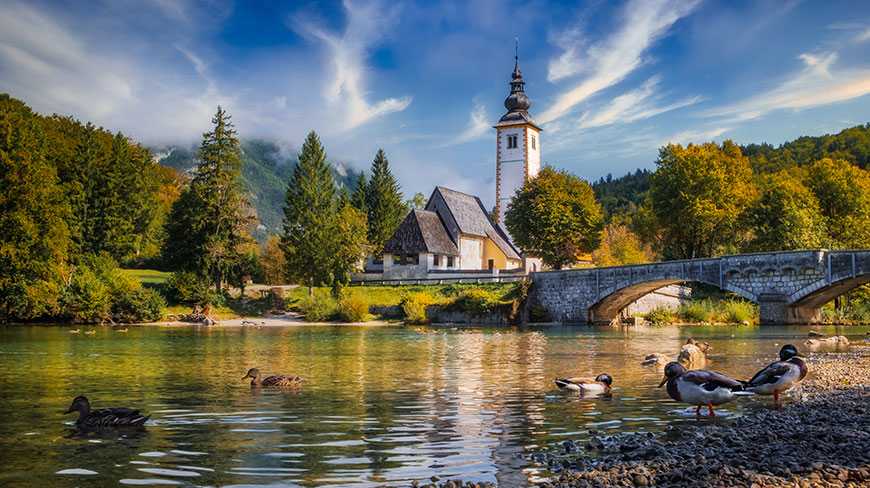Croatia/Slovenia
Exploring Slovenia & Croatia: A Journey Off the Beaten Path
Program No. 25459RJ
Go off the beaten path in Slovenia and Croatia and explore the unique natural wonders and rich cultural heritage of the Julian Alps and local villages.
Itinerary
While we make every effort to ensure the accuracy of our published materials, programs are typically advertised more than a year prior to their start date.
Read More.
While we make every effort to ensure the accuracy of our published materials, programs are typically advertised more than a year prior to their start date. As a result, some program activities, schedules, accommodations, personnel, and other logistics occasionally change due to local conditions or circumstances. Should a major change occur, we will make every effort to alert you. For less significant changes, we will update you during orientation. Thank you for your understanding.
Duration
13 days
12 nights
What's Included
24 meals (
11B, 5L, 8D
)
3 expert-led lectures
17 expert-led field trips
1 hands-on experience
1 performance
An experienced Group Leader
11 nights of accommodations
Taxes and customary gratuity
Road Scholar Assurance Plan
Day
1
In Transit to Program
Location:
In Flight
Day
2
Arrive Ljubljana, Check-in, Orientation, Welcome Dinner
Location:
Ljubljana
Meals:
D
Stay:
Eurostars uHotel
Activity Note
Hotel check-in from 2:00 p.m. Remember to bring your nametag (sent previously).
Dinner:
In the hotel dining room.
Evening:
At leisure. Continue getting to know your fellow Road Scholars, settle in, and get a good night’s rest for the day ahead.
Day
3
Ljubljana
Location:
Ljubljana
Meals:
B,D
Stay:
Eurostars uHotel
Activity Note
Walking for 2-3 miles, up to 2 hours, with periods of standing during the field trip.
Breakfast:
In the hotel dining room.
Morning:
We will begin with a lecture by a local expert on the topic of Slovenia. Followed by an expert-led walking field trip of Ljubljana. Ljubljana is the capital city of Slovenia, and one of the smallest capital cities in all of Europe. This city derives its name from the Ljubljanica River, which divides the city into two halves and provides an attractive and intimate boardwalk for visitors. The riverside area by the Old Town also includes many restaurants and coffee shops, making it a popular destination for locals and foreigners alike. Ljubljana’s unique character is heavily marked by the design of famous Slovene architect, Joze Plecnik, whose influence can be seen throughout the city. Ljubljana is known for its extensive pedestrian zone, reflecting the city’s commitment to green initiatives.
Lunch:
This meal has been excluded from the program cost and is on your own to have what you like. The Group Leader will be happy to offer suggestions.
Afternoon:
Free time. This period of time has been set aside for your personal independent exploration to see and do what interests you most. Please refer to the list of Free Time Opportunities. The Group Leader will be happy to offer suggestions. Please note that the period scheduled for free time is subject to change depending on local circumstances and opportunities for independent exploration. We suggest taking a cable car to discover Ljubljana Castle and admire the view of the city from above.
Dinner:
At a local restaurant.
Evening:
At leisure.
Day
4
Velika Planina
Location:
Ljubljana
Meals:
B,L
Stay:
Eurostars uHotel
Activity Note
Walking 2-3 miles, up to 3 hours. Getting on/off a bus; driving about 30 miles, under 1.5 hours total riding time. Getting on/off a cable car and chairlift to reach Velika Planina. Please note that the mountain visit is weather dependent.
Breakfast:
In the hotel dining room.
Morning:
We will board a bus for a drive from Ljubljana to the charming town of Kamnik, nestled at the foot of the Kamnik-Savinja Alps. From there, we’ll take a cable car and chairlift to Velika Planina, one of Slovenia’s most picturesque alpine plateaus. Upon arrival, we will join a local expert in a walk through the rolling meadows dotted with traditional shepherds’ huts, soaking in the tranquil atmosphere of the mountains. A walk leads us to the Preskar Hut Museum, a small, gray shepherd’s hut that stands out for its unique oval shape and modest interior. Rebuilt in 1945 by Andrej Preskar after the original was destroyed during World War II, the hut now offers a glimpse into the traditional life of the herdsmen. Inside, we’ll find a fascinating collection of tools and household items that were once part of everyday life on the plateau.
Lunch:
At a local restaurant, we will experience a true shepherd’s lunch.
Afternoon:
Before leaving the mountain, locals will introduce us to the traditional cheese-making practices of the region. One of the highlights is trnici, a distinctive hard cheese with a characteristic pear shape, traditionally produced on Velika, Mala, and Gojska Planina. Made from cottage cheese, cream, and salt, trnici are decorated with intricate patterns imprinted using carved wooden boards or sticks known as pisave. These cheeses are not only part of everyday meals, but also carry deep cultural meaning. In the past, shepherds would gift trnici to their wives or sweethearts as a symbol of love and loyalty at the end of the grazing season in autumn. Going back down to Kamnik, we’ll board the bus and and return to Ljubljana.
Dinner:
On your own. The Group Leader will provide you an insight in choices and possibilities in the very centre of Ljubljana.
Evening:
At leisure. Prepare for check-out and transfer in the morning.
Day
5
Postojna Cave, Opatija
Location:
Pula
Meals:
B,D
Stay:
Park Plaza Verudela Pula
Activity Note
Getting on/off a motorcoach; driving 125 miles from Ljubljana to Pula, approximately 3 hours riding time including a border crossing; please have your passports ready. During the Postojna Cave visit, a small train is used and the underground temperature is constantly 8-10° C (46-50° F); please bring a jacket or sweater.
Breakfast:
In the hotel dining room.
Morning:
After breakfast, we will board a motorcoach and start an hour-long ride towards the Postojna Cave. Upon arrival, we’ll enter one of the most famous karst cave systems in the world. The visit begins with a short electric train ride, followed by a guided walk through a series of stunning underground chambers, passageways, and dripstone formations. Postojna Cave stretches over 24 kilometers, with 5 kilometers accessible to visitors. It is a prime example of karst topography, formed over millions of years by the action of the Pivka River slowly dissolving the limestone bedrock. The cave features spectacular geological formations such as stalactites, stalagmites, flowstones, and natural bridges. It is also home to an underground river and the rare olm, a blind, cave-dwelling amphibian found only in this region. The cave has attracted visitors since the early 19th century and was the first in the world to feature a purpose-built railway for visitors, introduced in 1872. After, we will continue the ride during which our Group Leader will share local stories and knowledge.
Lunch:
On your own. The Group Leader will provide you an insight in choices and possibilities in Opatija.
Afternoon:
After lunch, we will join a local expert for a walking field trip of Opatija. Located on the Adriatic coast surrounded by woods of bay laurel, Opatija is mostly known as a seaside and winter resort town. This history dates to the 19th century, as Austrian Emperor Franz Joseph I used to spend several winter months living in Opatija and hosting royal guests from other kingdoms and empires of Europe. Because of this, Opatija is a treasure trove of 19th-century luxury architecture and villas. Later we will proceed by motorcoach to Pula.
Dinner:
In the hotel dining room.
Evening:
At leisure.
Day
6
Pula, Roman Amphitheater
Location:
Pula
Meals:
B,D
Stay:
Park Plaza Verudela Pula
Activity Note
Walking 2-3 miles, standing up to 3 hours during the field trip. There are over 60 steps up and down in Arena and in Small Roman Theater. The drive from Pula to. During the warmer, sunny days please take a hat for Arena as there is no shade all the time. Extent and duration of walking and other activities during free time according to personal choice.
Breakfast:
In the hotel dining room.
Morning:
The morning begins with a lecture on a local topic, focused on Istrian lifestyle and culture. This is followed by a field trip through Pula, led by a local expert. The first stop is the Pula Arena, a large Roman amphitheater built in the 1st century AD during the reign of Emperor Vespasian. Constructed entirely from local limestone, it is one of the six largest surviving Roman arenas in the world, notable for its fully preserved outer walls and underground passages that once supported various event functions. From there, the walk continues to the so-called Small Roman Theater, partly carved into a hillside and offering a different perspective on ancient public life. The route then leads through the historical core of the town, where layers of history unfold in the urban landscape. A key site along the way is the Forum, the main square of Roman Pula, once the center of civic and religious activity. Still in use today, the square features the well-preserved Temple of Augustus. To experience the rhythms of daily life, the local market would be ideal, also part of the field trip.
Lunch:
On your own.
Afternoon:
Free time. We recommend visiting The Historical and Maritime Museum of Istria or Pula Aquarium.
Dinner:
In the hotel dining room.
Evening:
At leisure.
Day
7
Experience Rural Istria
Location:
Pula
Meals:
B,L
Stay:
Park Plaza Verudela Pula
Activity Note
Getting on/off a motorcoach; driving about 40 miles, approximately 2 hours riding time. Walking up to 3 miles on rural paths. There are longer periods of standing, some stairs without railings.
Breakfast:
In the hotel dining room.
Morning:
With the Group Leader, we will explore the Istrian countryside, which remains very much alive, as most of the population still lives in smaller or larger villages scattered across the peninsula. Rural Istria, often referred to as the “Tuscany of Croatia,” offers a landscape of rolling hills, stone-built villages, fertile valleys, and a Mediterranean character deeply rooted in agricultural tradition. Stretching across the Croatian peninsula and brushing against southwestern Slovenia, Istria is a region where nature and heritage intertwine seamlessly. Agriculture forms the backbone of life here, with over 70 percent of the land used for farming. Small, often family-run farms dominate the area, cultivating vineyards, vegetable gardens, and especially olive groves. Olive farming holds a special place in the Istrian identity, with more than 6,000 hectares of land dedicated to olive trees and an annual production of 800 to 1,000 tons of olive oil. The region is known for its high-quality, award-winning oils, often produced using sustainable, organic methods. Olive oil has been part of Istria’s story since Roman times. The local Buza, Istarska Bjelica, and Leccino olive varieties are prized for their robust flavor profiles. Many producers combine traditional knowledge with modern cold-press techniques, resulting in oils with a fresh, grassy aroma and a slightly peppery finish.
Lunch:
At a local restaurant.
Afternoon:
Our first visit this morning will be to a family-owned olive farm, where we will learn more about olive cultivation, the rhythms of rural life tied to the groves, and of course, taste a selection of Istrian olive oils. Later in the day, we’ll continue to another family farm, this one focused on mixed agriculture, where vegetables are grown in home gardens and small numbers of animals are raised for household use. Here, we’ll walk through the gardens, meet the animals, and gain insight into daily life on a working farm. Before lunch, we’ll join our hosts in the kitchen to help prepare a traditional Istrian meal—perhaps hand-rolled fuzi pasta or a simple seasonal manestra. We’ll then enjoy the meal together, sharing in the flavors and customs that define everyday life in rural Istria. Upon our return to the hotel, the rest of the afternoon is free.
Dinner:
On your own.
Evening:
At leisure.
Day
8
Porec, Mediaval Istria
Location:
Pula
Meals:
B,D
Stay:
Park Plaza Verudela Pula
Activity Note
Getting on/off a motorcoach; driving about 100 miles, approximately 2.5 hours total riding time. Walking 3-4 miles, up to 3 hours; ground in Euphrasian Basilica is uneven, please be careful while walking. There are some hills and steps without railings.
Breakfast:
In the hotel dining room.
Morning:
Today we continue our journey through Istria, starting with a field trip to the coastal town of Porec, one of the region’s most historically layered settlements. Originally established as a Roman colony, Porec has preserved its classical urban layout, with a grid of stone-paved streets that still follows the plan of the ancient castrum. Through centuries of Byzantine, Frankish, Venetian, and Austro-Hungarian rule, the town developed a rich architectural and cultural legacy that remains visible today. The highlight of our field trip is the Euphrasian Basilica, a UNESCO World Heritage Site and a masterpiece of early Christian art and architecture. Built in the 6th century under Bishop Euphrasius, the complex includes a basilica, atrium, baptistery, bishop’s palace, and mosaics that are among the finest examples in Europe. The golden mosaics in the apse, depicting Christ and the Virgin Mary with saints and local martyrs, offer both spiritual and historical insight into the religious life of the early Byzantine world. The basilica also reveals layers of earlier churches, Roman foundations, and later medieval additions, making it a living monument that has been in continuous use for over 1,400 years. A quiet walk through its interior invites reflection on the enduring presence of faith, community, and artistry in this part of Istria.
Lunch:
On your own.
Afternoon:
In the afternoon, we will leave the coast and travel inland to one of Istria’s many small hilltop medieval settlements. These places were built on high ground for observation and defense, a common practice in the past to protect from invaders and control the surrounding area. The settlement features narrow cobbled streets, stone houses, and beautiful views of vineyards and olive groves stretching across the landscape. Such places have long played a role in the region’s cultural and agricultural life and remain important centers of local identity. Afterwards, we will stop at a nearby winery. Winemaking has been present in Istria since ancient times, shaped by both climate and local traditions. The region’s mild winters, warm summers, and red soil rich in minerals provide ideal conditions for growing grapes. Most vineyards in Istria are small and family-managed, with work often passed down through generations. At the winery, we will learn about grape growing and winemaking, followed by a tasting of local wines, such as Malvazija and Teran.
Dinner:
At the local winery.
Evening:
At leisure. Prepare for check-out and transfer in the morning.
Day
9
Secovlje Salt Pans, Piran
Location:
Piran
Meals:
B,L
Stay:
Hotel Piran
Activity Note
Getting on/off a motorcoach; driving about 70 miles, approximately 1 hour riding time from Pula to Piran including border crossing; please have your passports ready. Walking for up to 3 hours. Terrain at the Secovlje Salt Pans can be uneven and exposed to the sun, so comfortable shoes, water, and sun protection are recommended. In Piran, expect cobbled streets, some uphill paths, and steps without railings—please watch your step.
Breakfast:
In the hotel dining room.
Morning:
After check-out, we will head north by motorcoach to the Slovenian part of the Istrian Peninsula, a small coastal region that borders both Croatia and Italy. Though modest in size, this area has strong historical and cultural ties to its neighbors and shares many of the same Mediterranean traditions. Our morning is dedicated to the Secovlje Salt Pans Nature Park, located near the border with Croatia. This area is one of the oldest active saltworks in the Mediterranean, where salt has been harvested for over 700 years using traditional methods. The salt pans stretch across a wide coastal wetland and are also an important habitat for many bird species and other wildlife. During our field trip, we will take an expert-led walk through the salt fields and learn about the unique technique of petola – a special layer of biosediment that plays a key role in producing high-quality sea salt. A short lecture will introduce the historical, cultural, and economic importance of salt production in the region, as well as its connection to local trade, food preservation, and daily life.
Lunch:
At the local restaurant.
Afternoon:
After the salt pans, we continue to Portorož, a seaside town known for its long spa tradition and coastal promenade. Here, we will have a fish lunch, enjoying typical local dishes influenced by the sea and the nearby hinterland. In the afternoon, we travel to Piran, one of the most beautiful and well-preserved historical towns on the Slovenian coast. Shaped by centuries of Venetian influence, Piran is famous for its narrow, winding streets, stone houses, and a picturesque central square dedicated to the composer Giuseppe Tartini. The town’s old port, town walls, and hilltop church offer a glimpse into the region’s maritime and cultural history. There will be time to explore the town, stroll along the seafront, or relax in the charming atmosphere of this coastal gem.
Dinner:
On your own.
Evening:
At leisure. Prepare for check-out and transfer in the morning.
Day
10
Idrija Mercury Museum, Beekeeping
Location:
Bled
Meals:
B,L,D
Stay:
Hotel Kompas Bled
Activity Note
Getting on/off a motorcoach; driving about 140 miles, approximately 3.5 hours riding time. The visit to the Idrija Mercury Museum includes walking through underground tunnels with uneven surfaces, low ceilings, and steps without railings—please wear sturdy shoes and bring a light jacket. During the stop at a local beekeeper on the way to Bled, expect some walking on natural terrain; please be cautious and mindful of your surroundings.
Breakfast:
In the hotel dining room.
Morning:
As we check out of the hotel and travel from the charming Slovenian coast toward the stunning alpine beauty of Bled, our journey will take us through some beautiful landscapes. Today offers a wonderful contrast between Slovenia’s maritime past and its alpine heritage, with unique experiences along the way. Our first stop is the picturesque town of Idrija, nestled in a narrow valley surrounded by forested hills. Known for its centuries-old lace-making tradition and rich industrial history, Idrija is most famous for its mercury mine, one of the oldest in the world. Once a major hub of mercury production, the Idrija Mercury Mine is now a UNESCO World Heritage Site. Visitors can explore the atmospheric underground tunnels, discover how mercury was extracted and processed, and learn about the miners’ lives and the town’s global significance in the field of science and technology.
Lunch:
At a restaurant en route.
Afternoon:
Later in the day, we’ll visit a local beekeeper, offering a glimpse into one of Slovenia’s proudest traditions. Slovenia has the highest number of beekeepers per capita in the EU, and beekeeping is deeply woven into its cultural identity. The country is also the birthplace of Anton Jansa, a pioneer of modern apiculture, and the home of the gentle and productive Carniolan honeybee. In recognition of its dedication to bees and sustainable beekeeping, Slovenia initiated the celebration of World Bee Day, officially recognized by the United Nations and celebrated every year on May 20. During the visit, we’ll learn about the beekeeping process, the vital role bees play in biodiversity, and have a chance to taste some fresh, local honey.
Dinner:
At the hotel.
Evening:
At leisure.
Day
11
Lake Bohinj, Radovljica
Location:
Bled
Meals:
B,L,D
Stay:
Hotel Kompas Bled
Activity Note
Walking 2-3 miles, approximately 2.5-3 hours. The walk along Lake Bohinj follows mostly flat, natural paths, though some areas may be uneven or slightly muddy—comfortable walking shoes are recommended. In Radovljica, there are cobble streets and slight inclines, no railings.
Breakfast:
In the hotel dining room.
Morning:
We will start with an engaging lecture from a local expert on alpine lakes, where we’ll explore the geography and geology that shape Slovenia’s natural landscapes. This informative session will give us a deeper understanding of how these glacial lakes were formed and the ecological significance they hold within the Alpine region. After the lecture, we’ll board the motorcoach for a short and nice drive from Bled to Lake Bohinj, the largest natural lake in Slovenia. Surrounded by the majestic Julian Alps and nestled within Triglav National Park, Lake Bohinj is a symbol of green Slovenia. We’ll take a relaxing walk along the lakeshore, soaking in the fresh alpine air and pristine scenery.
Lunch:
At a local restaurant.
Afternoon:
We will continue to the charming village of Radovljica, a beautifully preserved medieval town known for its rich cultural heritage and traditional Slovenian architecture. Its picturesque old town, with colorful facades and cobbled streets, offers a glimpse into the country’s past. While in Radovljica, we will visit the Lectar Museum, located in a historic inn dating back to the 16th century. The museum celebrates the craft of “lectarstvo”—the traditional making of decorated honeybread. Here, we’ll take part in a hands-on workshop, where we’ll have the chance to try our hand at creating our own charming honeybread heart, a symbol of Slovenian folk tradition. We will also get to explore the museum with a staffer.
Dinner:
On your own.
Evening:
At leisure.
Day
12
Lake Bled
Location:
Bled
Meals:
B,D
Stay:
Hotel Kompas Bled
Activity Note
Walking for up to 2 miles, approximately 2 hours. The trail through Vintgar Gorge is mostly on wooden walkways with some stairs and uneven surfaces—please wear sturdy shoes and be cautious, especially near the water.
Breakfast:
In the hotel dining room.
Morning:
Today, we’ll begin with a short motorcoach drive from Hotel Park in Bled to one of Slovenia’s natural highlights—Vintgar Gorge. Carved by the Radovna River, the gorge features steep rock walls, clear pools, and a well-maintained path of wooden walkways and bridges. The walk through Vintgar Gorge provides a peaceful and scenic way to experience Slovenia’s natural landscape up close. After our walk, we’ll return to the shores of Lake Bled, where the Group Leader will show us the lakeside promenade and share a few suggestions for enjoying the area—whether it’s a scenic stroll, a spot for a light lunch, or one last taste of the famous Bled cream cake.
Lunch:
On your own.
Afternoon:
In the late afternoon, we’ll come together for dinner at a special location—the Avsenik Museum in the village of Begunje. This unique venue is dedicated to Slavko Avsenik, a key figure in Slovenian folk music and the creator of the internationally loved Oberkrainer sound. The museum not only honors Avsenik’s personal legacy but also showcases the broader tradition of Slovenian folk music, which has long helped preserve regional identity and bring communities together through song and dance. Before dinner, we’ll visit the museum to learn more from staff about his life and influence.
Dinner:
At the Avsenik Museum, we’ll enjoy a live accordion performance to accompany a relaxed dinner to close our journey. Share favorite experiences and enjoy camaraderie with new Road Scholar friends during our farewell dinner.
Evening:
Returning to the hotel, the evening is at leisure. Prepare for check-out and departure in the morning.
Day
13
Program Concludes, In Transit From Program
Location:
In Flight
Meals:
B
Activity Note
Hotel check-out by 11:00 a.m. See your program’s “Getting There” information regarding transfers.
Breakfast:
In the hotel dining room. This concludes our program.
Morning:
If you are returning home, safe travels. If you are staying on independently, have a wonderful time. If you are transferring to another Road Scholar program, detailed instructions are included in your Information Packet for that program. We hope you enjoy Road Scholar learning adventures and look forward to having you on rewarding programs in the future. Don’t forget to like our Facebook page or follow us on Instagram. Best wishes for all your journeys!
Please select a day to update the map
Map details are not available for this location.

